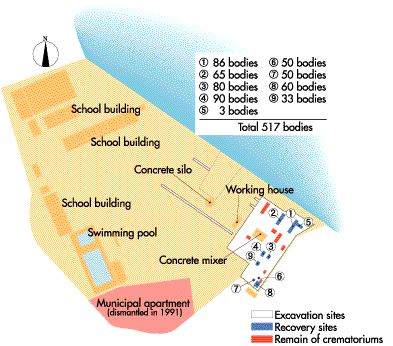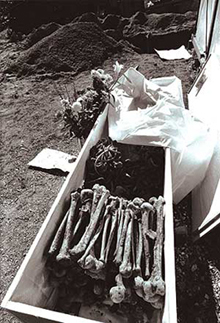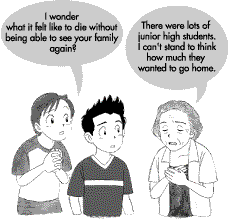 |
| Ninoshima of the Sleeping Dead |
| No accurate figures are available for the number that died. In 1947, the city of Hiroshima gathered remains on Ninoshima and erected the Hiroshima City War Victims Ninoshima Tower. After the war, the Horse Quarantine Station, where many bodies were thought to be buried, became home to the Ninoshima Elementary School, Ninoshima Junior High School (initially, Fourth Municipal Junior High School on Ninoshima). Municipal housing was also built on that site. |
| 59 Personal items collected with bodily remains Courtesy / Yoshitaka Nakatani November 1971, Aza Majidomari Ninoshima-cho |
 |
 61 Remains leaving Ninoshima Photographed and courtesy / Yoshitaka Nakatani November 4, 1971, Offshore from Ninoshima After being exhumed, the remains were held temporarily in the Ninoshima Temple. Then, after 26 years, they left Ninoshima and headed for Hiroshima. The remains were received and examined by the Medical Department at Hiroshima University, then they were cremated and placed into the Atomic Bomb Memorial Mound in Peace Memorial Park. |
| 60 Members of the Hiroshima War Disaster Consolation Association picking human bones out of dirt next to coffins Photo / Yuichiro Sasaki Courtesy / Kiyomi Sasaki November 1971, Aza Majidomari, Ninoshima-cho The Hiroshima War Disaster Consolation Association (previously, the Hiroshima War Victims Consolation Association) was formed in January 1946 for the purpose of gathering the remains cremated and buried in various locations around Hiroshima and giving them proper burials. Day after day they witnessed and assisted with the excavation on Ninoshima. |
 |
|
 |
The recovery of remains from the training garden of Ninoshima Junior High School
Duration October 29th - November 20th (23 days) Total excavated area 2,922m2 Recovery sites 9 sites, 107 m2 (approx. 517 bodies) Cremation sites 7 sites, 70 m2 (approx. 100 bodies) Recovered belongings 60 Bereaved family members who visited 126 individuals Remains identified by belongings 7 |
|
 |
62 Bones placed into a white wood coffin Photographed and courtesy / Yoshitaka Nakatani November 1971, Aza Majidomari, Ninoshima-cho An estimated 517 bodies were exhumed. Bone fragments and ash from approximately 100 partially cremated bodies were also found, bringing the total to 617 individuals. |
|
| 63 Victims' belongings displayed in the search for family Asahi Shimbun article dated November 27, 1972 Courtesy / Asahi Shimbun From November 26 to December 10, 1971, the Hiroshima Peace Memorial Hall (now, the Hiroshima Peace Memorial Museum) publicly displayed the belongings found on Ninoshima. Through this display, five victims were identified. Along with the two who were identified before the display began, a total of seven victims' remains were returned to their families after 26 |
||
 |
||
 |
64 Buckle This buckle was engraved with GRADUATE SUCCESS 2600. Hiroshima resident Chiyuki Tanabe told the authorities that he had designed the buckle himself. Thus, it was learned that it was one of 76 such buckles distributed to his classmates at Second Hiroshima Prefectural Junior High School to commemorate their graduation in 1940, which happened to be the 2600th year of the Japanese emperor. However, the owner of this buckle remains unknown. |
 |
 66 Newspaper article announcing the identification of Michie Wakida Chugoku Shimbun, November 17, 1971 |
| 66 Pass case and coin Approx. 1,200 m from the hypocenter, Zakoba-cho (now, Kokutaiji-machi) Donor / Fumio Wakida Michie Wakida (then, 14) was a second-year student at Yamanaka Girls High School attached to Hiroshima Women's Higher School of Education. She was exposed to the A-bomb at her building demolition worksite in Zakoba-cho. Her father, Hikoichi, found a note posted in the burned ruins of her school saying that Michie had died on the 9th on Kanawajima Island. He then learned that her body was transported to Ninoshima. Hikoichi went to Ninoshima on the 10th where he received only a few locks of her hair. This pass case, found during an excavation of graves on Ninoshima, says Michie Wakida, age 14. Thus, her remains were identified after 26 years. |
| Excavation of Remains on Ninoshima |  |
|||||||||||
|
| Excavation of Remains discovered in Ninoshima Junior High School in 1971 |
|
|
|
|||||||
|
|
|
|
|
|||||||
|
|||||||||
|
|
||||||||
|
Ninoshima and the Atomic Bombing
Island of Final Rest Military City Hiroshima and the Ninoshima Quarantine Station Atomic Bombing Relief Activities Immediately after the Bombing Ninoshima Overflowing with Injured Anguished Voices Calling for Water; Family Members Searching for Loved Ones Sending off the Dead The Closing of the Emergency Field Hospital, then the Quarantine Station A-bomb Orphans Ninoshima of the Sleeping Dead Conclusion Return to TOP |










